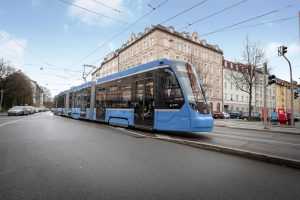 Siemens Mobility and Stadtwerke München (SWM) have completed the semiconductor tram tests carried out one year transporting passengers and covering 65,000 km in the process.
Siemens Mobility and Stadtwerke München (SWM) have completed the semiconductor tram tests carried out one year transporting passengers and covering 65,000 km in the process.
An Avenio tram has been equipped with semiconductor technology based on silicon carbide (SiC) and following trials, the two companies have presented the results of their research.
The study found that the motor noise produced by the vehicle fell sharply and the continuous monitoring of energy levels showed a 10 per cent reduction in energy consumption during the trips that the tram made on Munich’s public-transport rail network.
During the test, SiC semiconductor technology was installed in one of two traction converters used by a three-car Avenio tram. The test phase included all development tests necessary to gain authorisation for technology’s use in passenger service that were conducted in the company’s system test centre and in the vehicle.
“One factor plays a key role in the acceptance of trams – particularly in terms of new construction projects. Our vehicles must be as quiet as possible while in service. The project conducted with Siemens shows that we can not only optimise the noise levels of our vehicles but also improve our energy efficiency. We would be very interested in this solution if these improvements could be commercially mass-produced,” Ingo Wortmann, the Head of Mobility at SWM said.
The semiconductor tram tests were conducted as part of the European research and development project PINTA that has received funding from the Shift2Rail Joint Undertaking under grant agreement.
Two of three project phases have now been completed. The initial planning stage and the successful vehicle test for the SiC converter. The focal point of PINTA3 will be system optimisation created by the use of SiC in dual-system trams (tram-train). The objective of the PINTA project is to fuel the introduction of SiC technology to lower life-cycle costs and thus bolster the rail industry in Europe. The technology is already being used in a range of industrial sectors, including automotive electromobility.
Share on:



